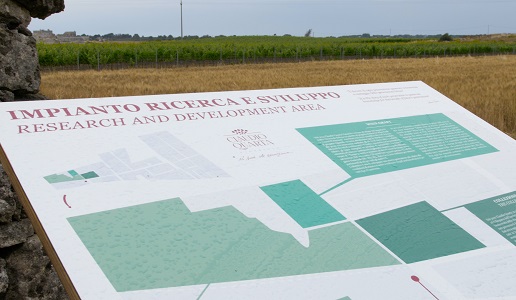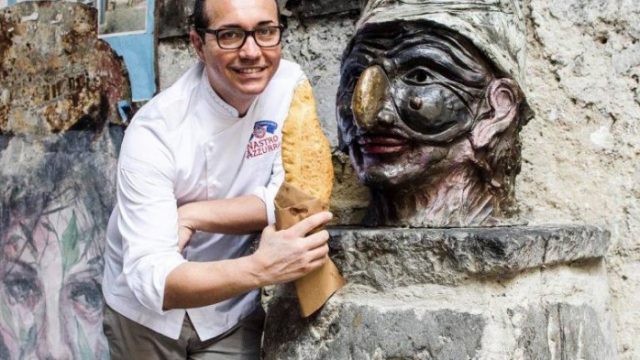The biodiversity collection of Claudio Quarta

The formula Claudio Quarta uses to run his estates is: sustainable development + new knowledge = increased development.
“It is the responsibility of every generation to enhance knowledge for the future”. This is what is written at the entrance to the biodiversity vineyard at the Tenuta Eméra estate in Lizzano, in the Puglia province of Taranto. In 2007, owner Claudio Quarta, in collaboration with the College of Agriculture at Milan University and the Insurbria Zoo, embarked on the “Biodiversity Collection” project to preserve a unique source of biodiversity and continue to study the characteristics and qualitative potential of varietals. In three years, they have planted six clones of over 500 minor grape varieties from the Mediterranean basin creating probably the largest vineyard of its kind in the world.
Since 2014, they have been conducting a screening through micro-fermentation based on aromatic profile, sugar content, acidity and the grape’s eventual resistance to disease. With his degree in biology and specialization in medical genetics, Claudio Quaranta went on to become a successful researcher and entrepreneur, creating a biotechnology pharmaceutical company that was listed on the Nasdaq in New York and the Nuovo Mercato (New Market) exchange in Milan. At the height of his career, in 1995, he made a significant life change, giving up his researcher’s smock and leaving both his company’s board of directors and the United States to return to Italy to fulfill a lifetime dream: becoming a winemaker.
In order to do this, he set up two other wineries aside from Eméra: Moros in Guagnano, in the Puglia province of Lecce, and Sanpaolo, in the province of Avellino in Campania. Today, these three together produce 670,000 bottles a year. Along with native varieties, he has also planted international varietals like the French Syrah, Merlot, Cabernet Sauvignon and Chardonnay, rigorously following the parameters of micro-zoning. The three areas were chosen with a single goal in mind: to produce wines that can reflect southern Italy by interpreting tradition and modernity with a rigorously scientific eye. In this endeavor he has been joined and supported by his radiant daughter Alessandra.
For Claudio, the concept of sustainability has been surpassed and the next step is incrementality, and the formula to do this: sustainable development + new knowledge = increased development. We discussed his philosophy in depth.
DoctorWine: Do research, tradition and innovation come together in your productive philosophy?
Claudio Quaranta: The concept of innovation is implicit in tradition. If each generation does not add something of its own to tradition, then it has failed to fulfill its responsibility and risks making tradition something to display in a museum, since it would no longer be an element of a people’s wealth and strength. What I aim to do is to make wines that, while maintaining their original traits, are elegant, fine and complex in order to appeal to more demanding palates. I wanted to make a wine that would be among the top 100 best wines in the world according to Wine Spectator. After 11 years, my Primitivo di Manduria Antico Sigilo 2014 was 63rd on the 2016 list.
DW: What criteria did you use in choosing the areas for your wineries?
CQ: My first choice was based on my desire to produce the great Puglia red wines, Primitivo and Negroamaro. I planted vines in Pulsani, LIzzano Marina, and created the Tenuta Eméra estate. Then I went to Sanpaolo in Torrioni because Campania whites, for me, are the best in the world. I could have stopped there but there was still a piece missing to complete the puzzle in my mind: Salice Salentino. Salice Salentino is a blend of Negroamaro with Malvasia Nera (no more than 15%) and it can only be produced in a restricted area southwest of Lizzano centered around the town of Guagnano. Here I acquired an old, small vineyard, which had an old outbuilding that I transformed into offices, and drastically reduced its yield. In Moros, I only produce one wine, of the same name, in a limited quantity, 6,500 bottles.
DW: Why is biodiversity to important?
CQ: Biodiversity is the basis of the evolution of man, the animal kingdom and plant life. Today more than ever people are talking about resilience in order to explain the importance of biodiversity. Many traumatic events have taken place over millions of years that were overcome by the capacity of living beings to change and adapt to new environments. All these changes resulted in biodiversity. This involved life, the fossils of which in northern Europe show how 65 million years ago it had a tropical climate. The separation of the two continental blocs, America and Eurasia, along with repeated glacial eras resulted in living populations, already different from each other, becoming even more different, creating different species.
DW: What was the goal behind the creation of the Biodiversity Collection?
CQ: There were three: preserve the enormous wealth that derives from biodiversity and that, if lost, would cause incalculable damage because the ability to resist and improve would be lost; select varietals that, thanks to their organoleptic characteristics, can produce particularly interesting wines; and to isolate those varieties that are naturally resistant in order to understand the mechanisms of this resistance and create native varietals that are immune or resistant to pathogenic agents without resorting to the use of chemical agents.
DW: At what point is your research, which are the more interesting varietals?
CQ: It has been carried out in collaboration with the Milan University College of Agriculture. More precisely, we are working with Professors Attilio Scienza and Osvaldo Failla and their teams. They have done all the work on the traits of the grapes which has led to identifying some, of Georgian origin, which we are increasing our knowledge of. This year we will also have the support of the enology department at the University of Lecce.
DW: How much truly sustainable development is possible in Puglia?
CQ: We have some virtuous entrepreneurs and others who are less so. We should all feel it is our responsibility to have an ethic in our work and in our social life. In other words, everyone (no one excluded) can and must contribute to sustainable development or, better yet, incremental development.
DW: What is Claudio Quaranta’s style?
CQ: In order to understand my style, one must ask why make wine. The why is key to the how and thus the what. My reason why is because I want to make southern wines that can move you, which can express the greatest quality possible by applying a process that I define as “truth”. In other words, an authentic manifestation of the traits of a varietal and a territory without changing them through extreme intervention in the winery. My frame of mind coincides with Plato’s idea of pre-existence. When applied to wine, this means that a wine is a product that can derive from a grape’s spontaneous development, even if this process does not make a quality wine, but that’s another story, and it is already present in the vineyard. One need only bring it out without excessive manipulation.
DW: What do you think about the biodynamic method?
CQ; If we look at it from a holistic point of view, I could agree with it, but the “druid” practices belong to a dark past and it’s beyond me how they can find followers in today’s day and age.
Related Products
| Product | Producer | Date of publication | Author | Read | |
|---|---|---|---|---|---|

|
Claudio Quarta
|
11/09/17 | Redazione |
Claudio Quarta is an agricultural entrepreneur who has a number of estates in the regions of Puglia and Campania. Emèra is the largest and is situated in the Maduria Doc appellation, where... Leggi tutto |

 Italiano
Italiano








